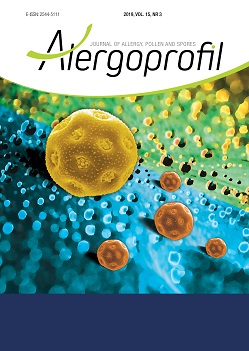Characterisation of Tilia pollen seasons in 2018–2019
##plugins.themes.bootstrap3.article.main##
Abstrakt
Literature reports suggest that Tilia pollen exhibits low or moderate allergenicity. The aim of the study was to compare the pollen seasons of this taxon in seven Polish cities in 2018 and 2019. The aerobiological research stations were located in Bialystok, Cracow, Lublin, Piotrkow Trybu-nalski, Sosnowiec, Szczecin, and Warsaw. Aerosol samples were collected with the volumetric method using Burkard or Lanzoni pollen samplers. The length of the pollen season was determined using the 95% method. The earliest onset of the Tilia pollen season was noted in Cracow in both years of the study. In 2018, it began already in May. The highest concentrations of lime pollen grains were recorded in Lublin, whereas the lowest values were reported from Bialystok and Cracow. The maximum daily Tilia pollen concentration was recorded in most of the measurement sites between June 6th and June 11th in 2018 and between June 16th and June 24th in 2019. The annual pollen grain sum in both study years was the highest in Lublin (971, 844), whereas the lowest values were noted in Bialystok (85, 102) and Cracow (111, 75). The concentrations of Tilia pollen in Lublin in 2018 and 2019 were several times higher than the mean values recorded in this city in 2001–2017. The allergen index calculated for Tilia trees growing in the centre of Lublin indicates a moderate allergenic threat posed by the pollen of this taxon to the residents of the city.
Pobrania
##plugins.themes.bootstrap3.article.details##
Copyright: © Medical Education sp. z o.o. This is an Open Access article distributed under the terms of the Attribution-NonCommercial 4.0 International (CC BY-NC 4.0). License (https://creativecommons.org/licenses/by-nc/4.0/), allowing third parties to copy and redistribute the material in any medium or format and to remix, transform, and build upon the material, provided the original work is properly cited and states its license.
Address reprint requests to: Medical Education, Marcin Kuźma (marcin.kuzma@mededu.pl)
Bibliografia
2. Seneta W, Dolatowski J. Dendrologia. Wydawnictwo Nauko-we PWN, Warszawa 2008.
3. Weryszko-Chmielewska E, Sadowska D. The phenology of flowering and pollen release in four species of Linden (Tilia L.). J Apic Sci 2010, 54(2): 99-108.
4. Kuchcik M, Dudek W, Błażejczyk K et al. Two faces to greenry on housing estates-mitigating climate but aggravating allergy. A Warsaw case study. Urban For Urban Green 2016, 16: 170-181.
5. Proctor M, Yeo P, Lack A. The Natural History of Pollination. Harper Collins Publishers, London, Glasgow, Sydney, Auckland, Toronto, Johannesburg 1996.
6. Willmer P. Pollination and Floral Ecology. Princeton University Press, Princeton and Oxford 2011.
7. Mur P, FeoBrito F, Lombardero M et al. Allergy to linden pollen (Tilia cordata). Allergy 2001, 56: 457-458.
8. Igić R, Boža P, Anačkov G et al. Allergenic plants in city of Novi Sad; Efflorescence calendar of allergenic plants. In: Vesković M (ed). Atlas of Allergenic Plants in City of Novi Sad. University of Novi Sad, Faculty of Sciences 2005.
9. Mrđan S, Ljubojević M, Orlović S et al. Poisonous and allergenic plant species in preschool’s and primary schools’s yard in the city of Novi Sad. Urban For Urban Green 2017, 25: 112-119.
10. Cariñanos P, Casares-Porcel M, Quesada-Rubio JM. 2014. Estimating the allergenic potential of urban Green spaces: A case-study in Granada, Spain. Landscape Urban Plan 2014, 123: 134-144. https://doi.org/10.1016/j.landurbplan.2013.12.009.
11. Hruska K. Assessment of urban allergophytes using an allergen index. Aerobiologia 2003, 19(2): 107-111.
12. Dąbrowska A, Piotrowska-Weryszko K, Weryszko-Chmielewska E et al. Flowering phenology of selected linden (Tilia L.) taxa in relations to pollen seasons. J Apic Sci 2016, 60(20): 193-207.
13. Weryszko-Chmielewska E, Piotrowska-Weryszko K, Dąbrowska A. Response of Tilia sp. L to climate warming in urban conditions – phenological and aerobiological studies. Urban For Urban Green 2019, 43(2019): 126369.
14. Dąbski M, Oleś A, Parzymies M. Drzewa i krzewy w śródmieściu miasta Lublina. Zeszyty Problemowe Postępów Nauk Rolniczych 2006, 510: 127-135

